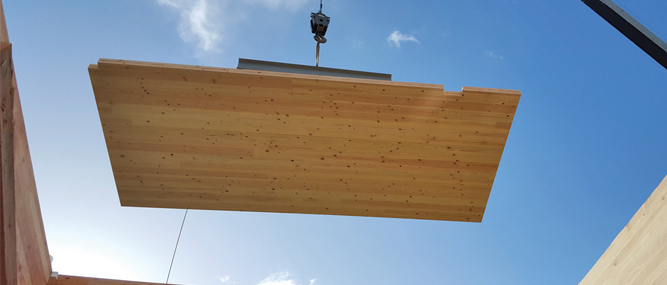The International Code Council (ICC) is clearing the way to expand the use of mass timber building products in the United States — like cross laminated timber (CLT) — and allow its use in taller buildings.
The move is viewed as a boon to the budding industry that manufactures CLT, now limited to a small handful of producers in the U.S. and Canada. Implementation of new building codes that incorporate mass timber construction likely are only a few short years away.
The ICC, which develops model building codes that are adopted by most U.S. states and communities, in December released the unofficial voting results on proposed code changes it considered in 2018. They included passage of the entire package of 14 proposed code changes for tall mass timber construction, according to the American Wood Council.
The proposals create three new types of construction that set fire safety requirements, allowable heights, areas and number of stories for tall mass timber buildings. The three new types of construction would permit mass timber buildings ranging from nine to 18 stories tall.
Official results are expected to be announced during the first quarter of 2019, and the new provisions would be included in the 2021 International Building Code (IBC), according to the AWC, which is a trade organization serving the wood products industry.
CLT is an engineered wood building product made by gluing layers of boards to form panels with the layers set perpendicular to one another. It is commonly used for long spans in walls, floors and roofs.
Currently only one state — Oregon — allows CLT in tall building construction up to 18 stories, having modified its building code in 2018. Washington has taken similar action, and it will be effective in March of this year.
Last fall, California Gov. Jerry Brown issued an executive order encouraging the adoption of mass timber material into the state’s building code, although the step is likely a few years away.
CLT already has been approved by 30 states for construction of buildings up to six stories tall (85 feet) since being recognized by the IBC in 2015. “Eighty-five feet is the current maximum allowable building height for mass timber,” said Kenneth Bland, vice president of codes & regulations for the American Wood Council. “The 2021 IBC will permit mass timber buildings up to 270 feet high (24-25 stories) for certain occupancies.”
Most states have processes to update their building codes. Once the new provisions of the IBC are available in late 2020, individual states would begin those processes to adopt them, noted Bland, so adoption likely is a few years off.
However, the issue is an important priority for many states, indicated Robert Glowinski, AWC president & CEO. “There has been a lot of interest from the states to accelerate the tall wood provisions,” he said. “We expect that there will be more states acting ahead of the normal updating process to enable the construction of tall mass timber buildings.”
Those states with a strong lumber or forest products industry would be particularly interested in accelerating the process, he suggested. There has been strong interest among states in the Northeast, Mid-Atlantic, Upper Midwest, and Southeast, he added.
The response of the forest products industry to the IBC action has been “very positive,” said Glowinski. “They’re very pleased with what the ICC has done.”
The number of companies manufacturing CLT has doubled in the past two years “and we know there are others in the pipeline,” said Glowinski. Currently, two U.S. companies produce CLT, and three in Canada. Other production facilities are being planned.
The forest products industry is a conservative one, Glowinski noted, and there are likely other companies that are considering investments to produce CLT but have been waiting to see what the ICC would do. “With this approval…we will likely see more capacity coming on line in the United States.”
The use of mass timber for tall building construction is much more advanced in other countries, noted Glowinski. There are hundreds of buildings around the world constructed with mass timber building products, and more are being constructed, particularly at taller heights. For example, a 24-story mass timber building is under construction in Vienna, Austria, that will contain apartments, offices and a hotel.
“The solid wood industry in North America sees this as a huge opportunity,” said Glowinski, “not just for the industry, but for the ability for the tall building marketplace to undergo a fundamental change.” Wood is a carbon sequestering product, he noted, and therefore is attractive for environmental reasons. “We hope the code change will…spur a fundamental change in how we construct tall buildings in the United States.”
“The addition of tall mass timber to the International Building Code provides a comprehensive set of safety standards for these new types of construction. This vote caps off several years of scientific research and testing, and verifies that mass timber meets the robust performance standards called for by our nation’s building codes,” Bland said in a news release issued by the AWC in December.
A panel of experts explored the unique benefits building with mass timber as well as how the product’s evolution has brought it back into the building spotlight at an event hosted by Swinerton, a national construction firm, in San Francisco in October 2018.
“In a way heavy timber construction goes back centuries,” said William Silva, director of project development for Swinerton. “It’s really an older building type that was left behind, and what’s happening now is that heavy timber is being implemented in a different way.”




